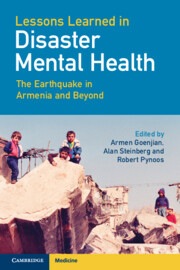Book contents
- Lessons Learned in Disaster Mental Health: The Earthquake in Armenia and Beyond
- Frontispiece
- Lessons Learned in Disaster Mental Health: The Earthquake in Armenia and Beyond
- Copyright page
- Contents
- Dedication
- Preface
- Contributors
- Chapter 1 The 1988 Spitak Earthquake in Armenia and the Implementation of the Psychiatric Outreach Program
- Chapter 2 Diaspora Therapists Working in the Earthquake Zone
- Chapter 3 Treatment Outcome among Early Adolescents Two Decades Post-Earthquake
- Chapter 4 Course and Predictors of PTSD and Depression among Not Treated Children and Adolescents over Two Decades
- Chapter 5 Conscience, Moral Injury, and Psychopathology
- Chapter 6 Natural Disasters and Relocation
- Chapter 7 Long-Term Course of PTSD and Depression Among Adults, Mediating and Moderating Factors in Recovery, and Current Trends for Treatment
- Chapter 8 How the Spitak Earthquake Contributed to our Understanding of the Genetics of PTSD and Associated Disorders
- Chapter 9 Epidemiology of Disasters and the Spitak Earthquake
- Chapter 10 Traumatic Stress Conceptual Framework
- Chapter 11 Memoirs of the Spitak Earthquake
- Chapter 12 Lessons Learned from the Spitak Earthquake and Other Catastrophic Disasters
- Index
- Plate Section (PDF Only)
- References
Chapter 5 - Conscience, Moral Injury, and Psychopathology
Published online by Cambridge University Press: 20 May 2022
- Lessons Learned in Disaster Mental Health: The Earthquake in Armenia and Beyond
- Frontispiece
- Lessons Learned in Disaster Mental Health: The Earthquake in Armenia and Beyond
- Copyright page
- Contents
- Dedication
- Preface
- Contributors
- Chapter 1 The 1988 Spitak Earthquake in Armenia and the Implementation of the Psychiatric Outreach Program
- Chapter 2 Diaspora Therapists Working in the Earthquake Zone
- Chapter 3 Treatment Outcome among Early Adolescents Two Decades Post-Earthquake
- Chapter 4 Course and Predictors of PTSD and Depression among Not Treated Children and Adolescents over Two Decades
- Chapter 5 Conscience, Moral Injury, and Psychopathology
- Chapter 6 Natural Disasters and Relocation
- Chapter 7 Long-Term Course of PTSD and Depression Among Adults, Mediating and Moderating Factors in Recovery, and Current Trends for Treatment
- Chapter 8 How the Spitak Earthquake Contributed to our Understanding of the Genetics of PTSD and Associated Disorders
- Chapter 9 Epidemiology of Disasters and the Spitak Earthquake
- Chapter 10 Traumatic Stress Conceptual Framework
- Chapter 11 Memoirs of the Spitak Earthquake
- Chapter 12 Lessons Learned from the Spitak Earthquake and Other Catastrophic Disasters
- Index
- Plate Section (PDF Only)
- References
Summary
This chapter provides an overview of the process of moral development and the five domains of conscience functioning in children and adolescents. It describes how moral development and conscience functioning are affected by moral injuries and exposure to a natural disaster, specifically the 1988 Spitak earthquake. Alterations to conscience development and interference with conscience functioning resonate with the concept of moral injury, scientific studies of which have described moral injury in both combat and civilian populations. Both fields have been hampered by the fact that the current psychiatric diagnostic system for PTSD and depression in DSM-5, although identifying cognitive disturbances as symptoms, does not include specific reference to the moral domain. While symptoms of PTSD and depression may co-occur with conscience impairment, the moral injury involved requires creative methods for delineating the impact on demoralization and identifying potential treatments for re-moralization. Examples of conscience-sensitive evaluation methods for the domains of conscience – conceptualization, moral attachment, moral-emotional responsiveness, moral valuation, and moral volition – are presented. Each domain points the way to treatment possibilities.
Keywords
- Type
- Chapter
- Information
- Lessons Learned in Disaster Mental HealthThe Earthquake in Armenia and Beyond, pp. 73 - 96Publisher: Cambridge University PressPrint publication year: 2022



